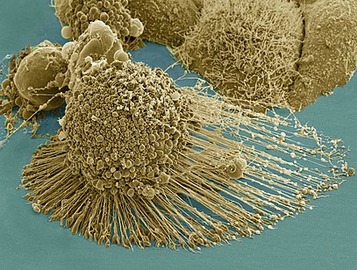Today, we shall scratch the surface on HeLa cells.
Overview:
- What are HeLa cells?
- Where did they come from?
- Why are they so important?
- Ethics Things
What are HeLa cells?
HeLa cells, also known as Hela or hela cells, are a strain of human cell that can be cultured without dying. When they were first cultured in Ye Olden Days (late 1940s, early 1950s) it was a really big deal because previously, human cells would die after a few days. The guy who figured this out, George Otto Gey, freely distributed this cell line, which, slay of him ig. We will talk more about this later. HeLa cells aren't actually anything super fancy, except they are good because they do not die (they are immortal cells, meaning they do not have the normal self-destruct that other cells do after replicating a certain number of times called senescence) and they are human tissue which means human research. Nice.
Where did they come from?
Being human tissue, it would be reasonable to assume they came from a human. More specifically, HeLa cells come from the cervical cancer that would eventually kill one Henrietta Lacks, an African-American mother of five. They are also named after her - Henrietta Lacks. They originate from a biopsy (tissue sample) taken to confirm her cancer diagnosis, after which they were considered the property of the physician who ordered the biopsy. This will be important later. Henrietta Lacks died when she was 31 or 32 in 1951.
Why are they so important?
HeLa cells, as the earliest immortal cell line, have been used in lots of medical research as an alternative to actual people. They were notably but not only used for research into the polio vaccine, quickly becoming an important item in any medical researcher's toolbox. Human experimentation carries ethical problems at times, and HeLa cells were a way to conduct tests without risking someone's life.
Ethics
So far, the story of Henrietta Lacks and HeLa cells has been pretty chill, right?
Well...
First: the cells were taken from Mrs. Lacks without consent. In modern medicine, informed consent is very important, but Henrietta Lacks did not know that the cells would be kept after the biopsy. They were cultured without her knowledge and widely distributed and sold without any compensation. They also have her name attached to them, which is considered an insane breach of ethics nowadays. Her family had no say in what would be done and they did not have access to her files. While HeLa cells were revolutionizing medicine, they still had very limited/nonexistent access to healthcare.
HeLa cells were also used in a lot, and I mean a lot of questionable-at-best experiments. Usually these involved desperate people who were very poor, or people in prisons who really didn't have much of a choice. One of the many examples of VERY horrid experiments had a slurry of HeLa cells injected into inmates. Now, you must remember that these are cancerous cells. Scientists injected live cancer cells into people to see if it would spread, and most of these people developed tumors. There are many more of these horrific incidents and so much more about the history of the use of HeLa cells, the woman herself, the scientists...all of it, but I really want to sleep and also in the interest of not message bombing, I will leave it here as a very short introduction.
I found out about HeLa cells a few years ago from the wonderful book "The Immortal Life of Henrietta Lacks" by Rebecca Skloot, and would highly recommend the read. It includes interviews with Lacks' family, scientific and historical context, and much more in-depth writing about the incredible history of this woman and her cells.
Image credits: HeLa Wikipedia page

Comments
Post a Comment